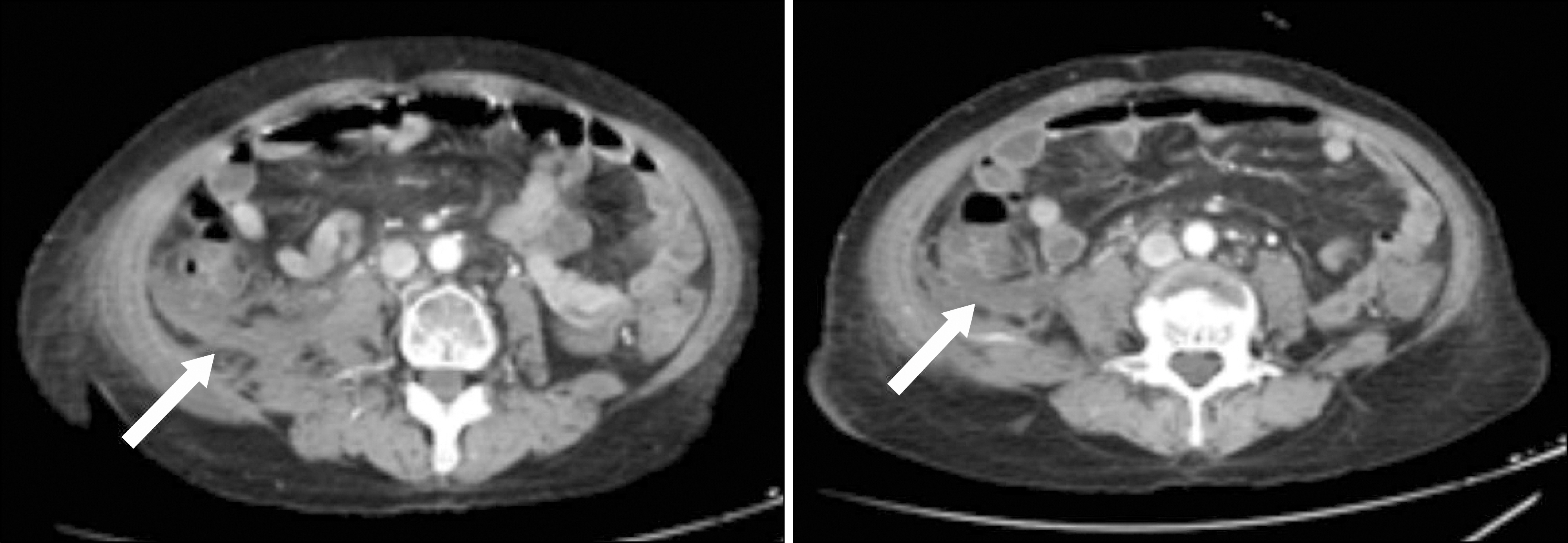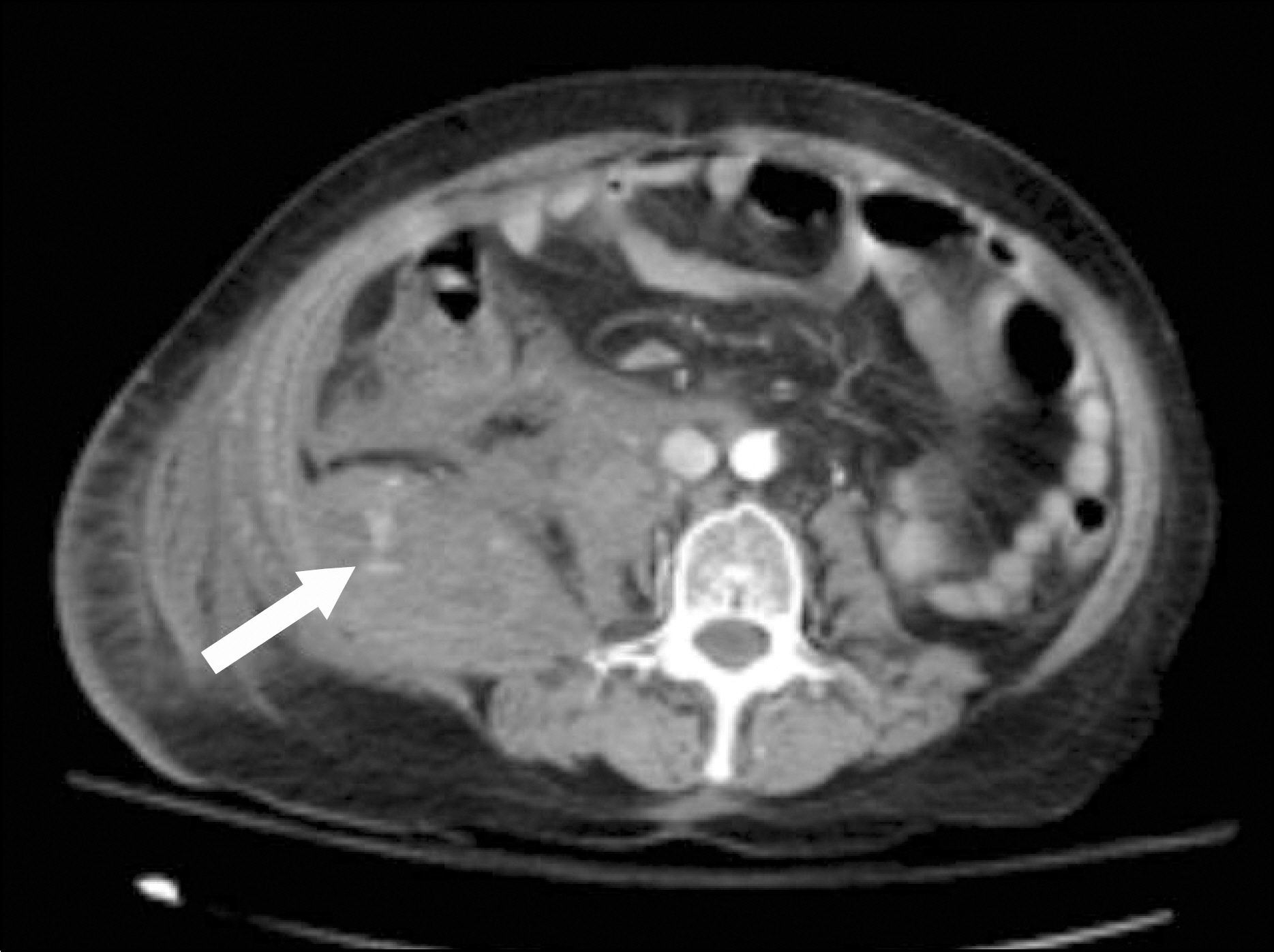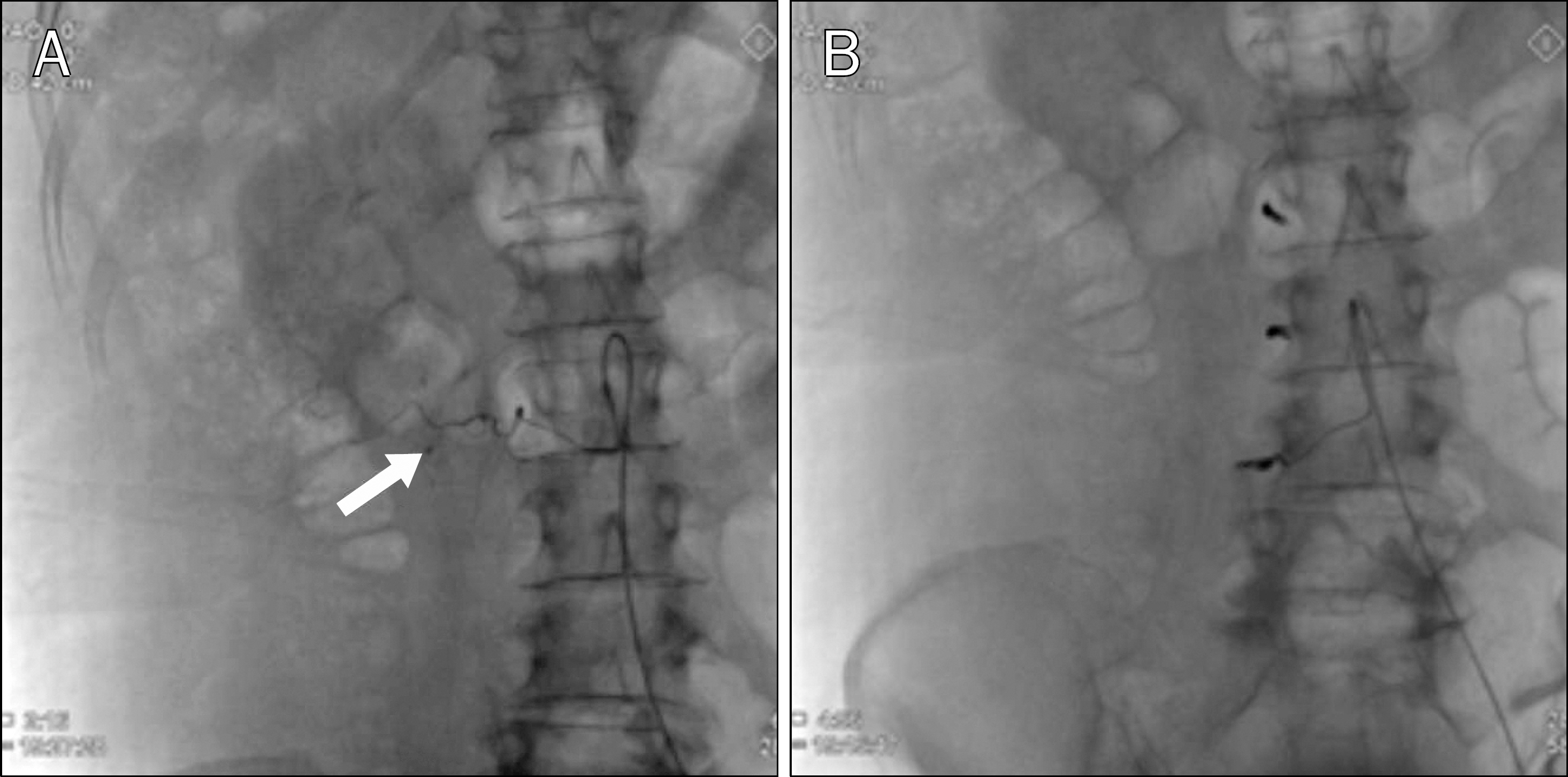Korean J Gastroenterol.
2015 Mar;65(3):186-189. 10.4166/kjg.2015.65.3.186.
A Case of Spontaneous Bleeding of Multiple Lumbar Arteries in a Patient with Liver Cirrhosis
- Affiliations
-
- 1Department of Internal Medicine, Gangneung Asan Hospital, Ulsan University College of Medicine, Gangneung, Korea. jwoojini@naver.com
- KMID: 2373206
- DOI: http://doi.org/10.4166/kjg.2015.65.3.186
Abstract
- Esophageal and gastric varix, portal hypertensive gastropathy, Mallory-Weiss tear and gastric ulcer are common causes of bleeding in patients with liver cirrhosis. However, spontaneous arterial bleeding without a history of trauma is a rare cause of bleeding which can be fatal. We report a case of a 55-year-old woman with alcoholic liver cirrhosis who developed spontaneous bleeding of multiple right lumbar arteries and died in spite of repetitive transfusion and embolization.
MeSH Terms
Figure
Reference
-
References
1. Stanley AJ, Robinson I, Forrest EH, Jones AL, Hayes PC. Haemodynamic parameters predicting variceal haemorrhage and survival in alcoholic cirrhosis. QJM. 1998; 91:19–25.
Article2. D'Amico G, Garcia-Pagan JC, Luca A, Bosch J. Hepatic vein pres-sure gradient reduction and prevention of variceal bleeding in cirrhosis: a systematic review. Gastroenterology. 2006; 131:1611–1624.3. Craxì A, Cammà C, Giunta M. Clinical aspects of bleeding complications in cirrhotic patients. Blood Coagul Fibrinolysis. 2000; 11(Suppl 1):S75–S79.
Article4. Sharara AI, Rockey DC. Gastroesophageal variceal hemorrhage. N Engl J Med. 2001; 345:669–681.
Article5. Caldwell SH, Hoffman M, Lisman T, et al. Coagulation in Liver Disease Group. Coagulation disorders and hemostasis in liver disease: pathophysiology and critical assessment of current management. Hepatology. 2006; 44:1039–1046.
Article6. Ewe K. Bleeding after liver biopsy does not correlate with indices of peripheral coagulation. Dig Dis Sci. 1981; 26:388–393.
Article7. Segal JB, Dzik WH. Transfusion Medicine/Hemostasis Clinical Trials Network. Paucity of studies to support that abnormal coagulation test results predict bleeding in the setting of invasive pro-cedures: an evidence-based review. Transfusion. 2005; 45:1413–1425.
Article8. Tripodi A, Mannucci PM. The coagulopathy of chronic liver disease. N Engl J Med. 2011; 365:147–156.
Article9. Sugiyama C, Akai A, Yamakita N, Ikeda T, Yasuda K. Muscle hematoma: a critically important complication of alcoholic liver cirrhosis. World J Gastroenterol. 2009; 15:4457–4460.
Article10. Huang HH, Lin HH, Shih YL, et al. Spontaneous intracranial hemorrhage in cirrhotic patients. Clin Neurol Neurosurg. 2008; 110:253–258.
Article11. de Lange DW, Hijmering ML, Lorsheyd A, et al. Rapid intake of alcohol (binge drinking) inhibits platelet adhesion to fibrinogen under flow. Alcohol Clin Exp Res. 2004; 28:1562–1568.
Article12. Hama Y, Iwasaki Y, Kawaguchi A. Spontaneous rupture of the lumbar artery. Intern Med. 2004; 43:759.
Article13. Lee TH, Park YS, Chung DJ, et al. Spontaneous rupture of the lat-eral thoracic artery in patients with liver cirrhosis. Korean J Intern Med. 2008; 23:152–155.
Article14. Best JA, Smith MW. Spontaneous retroperitoneal hematoma originating at lumbar arteries in context of cirrhosis. J Hosp Med. 2010; 5:E4–E5.
Article15. Sharma P, McDonald GB, Banaji M. The risk of bleeding after percutaneous liver biopsy: relation to platelet count. J Clin Gastroenterol. 1982; 4:451–453.16. Toy P, Popovsky MA, Abraham E, National Heart, Lung and Blood Institute Working Group on TRALI, et al. Transfusion-related acute lung injury: definition and review. Crit Care Med. 2005; 33:721–726.
Article
- Full Text Links
- Actions
-
Cited
- CITED
-
- Close
- Share
- Similar articles
-
- Spontaneous Arterial Bleeding in Patients with Alcoholic Liver Cirrhosis: a Series of Three Cases
- Spontaneous rupture of the lateral thoracic artery in patients with liver cirrhosis
- Three Cases of Spontaneous Muscle Hematoma in Alcoholic Liver Cirrhosis
- Spontaneous Rupture of the Internal Thoracic Artery Causing a Mediastinal Hematoma in a Patient with Alcoholic Liver Cirrhosis: A Case Report
- A Case of Acquired Multiple Arteriovenous Malformations on the Scalp in the Patient of Liver Cirrhosis




